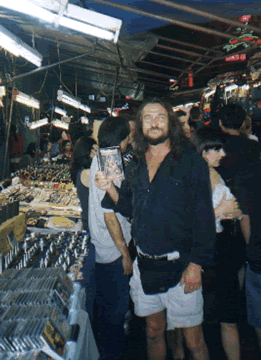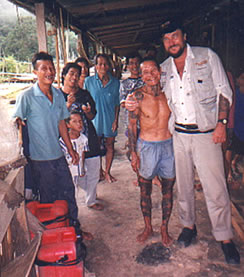Vanishing Tattoo --
Trip Updates
|
|
| Sunday, November 19th
Leaving Borneo is bittersweet, but Bangkok awaits. Thomas
and I spent the last day in Kuching in the company of Edward David, talking about the future
of Iban tattooing, distributing flash to the various tattoo shops, trading
photos and addresses and e-mail with all our new friends and saying our
good-byes. Eddie & Simon David As we fly to Bangkok, I ponder one of our last conversations that Thomas and I had with the Davids. One of things we discussed, and at times the conversation grew passionate, is what constitutes a "tribal tattoo"? What exactly "is" a tribal tattoo? Is it the design? The implements used, the native pigments, the rituals involved in its creation? Is it the tattoo artist? Can a German tattoo artist using a stenciled design and an electric machine in a shop in Berlin truly be said to be producing a tribal tattoo? And if the answer is no, is not imitation the sincerest form of flattery? This is a conversation worth having in the tattoo world. In our brief journey so far, Thomas and I have crossed the paths of other tattoo artists who were also in search of adventure in Borneo. And since Thomas's first trip in 1996 there have been an even greater number of tattooists in the area. And like a younger Thomas, these artists, whose love of tattooing is unquestioned and whose intentions are no doubt well meant, have been distributing more electric machines. The result has been to wreak havoc with the way traditional tattooing is being carried out. In their desire to encourage the aboriginal peoples to tattoo, these artists have literally showered them with new tattooing technology. On the surface this seems like a good idea, but the consequences of these actions are far reaching, and often times devastating. When a new electric machine enters a tribal tattooing community the first casualty is usually the traditional implements. They tend to be abandoned. And then the question of who actually "owns" the new machine arises. The old implements, while much simpler, by the very nature of their simplicity were widely available. And despite all the advertisements in the tattoo magazines offering their $295 "Tattoo Starter Kits", that promise that you too can become a professional tattoo artist in no time flat with their easy-to-use "Instructional Manual", using an electric machine is not that easy for a neophyte. An electric machine is easy to use, but much more difficult to master. To become a master tattoo artist with an electric machine takes many years of dedicated practice and commitment. And because of the electric machines relative rarity and expense in a tribal community questions of ownership take on much greater import. Instead of everyone tattooing in the community or a group of people tattooing, with the introduction of a single machine you effectively get "one" tattoo artist. Among the Iban, all the men traditional tattooed each other. And another issue soon gets raised. When everyone is tattooing everyone
else, very little, if any money changes hands. Certain individuals, as in
any field of endeavor, acquire a reputation as being a "good tattooist" within an Iban Longhouse. But that doesn't discourage others from carrying
out the practice. So the practice of many individuals tribal tattooing within the longhouse as a communal bonding and socializing practice gradually gives way to fewer and fewer men tattooing and it begins to take on the air of an act of commerce. The tattooist and the individual getting the tattoo, even if the design is traditional, are distanced from each other. But all too often, the designs aren't traditional. An electric machine, with its ability to do ten or twenty times the work of traditional tattooing implements and methods leads to all kinds of tattooing. And with an electric machine, the "new" tattooist feels he has to offer his "new clients" something more than just a traditional tattoo for their money. You can see some pretty interesting interpretations of "western" tattoos out there in the jungle. Thomas now wishes he could take back every electric tattoo machine he's ever given away, with few exceptions. But now we are off to find Jimmy Wong, who Thomas first met back in 1981 and the Monks who tattoo in the temples to the north of Bangkok. Vince Hemingson from Bangkok November 19th, 2000 -- Vince Hemingson Bangkok is... Bangkok. Hot. Humid. With an odour that can only be described as... Bangkok. Uniquely it's own, but not unfamiliar to those acquainted with open air markets all over Southeast Asia where everything, including your senses is assaulted by the sun. I am teetering on the brink of olfactory overload. Thomas and I have been spoiled by Borneo where an astonishingly high percentage of Malaysians spoke English. Harder to find than someone who speaks the Queen's tongue - is a yellow pages. Of course when we find it, it is incomprehensible to us, like Egyptian hieroglyphics. People have heard of the Monks who tattoo. And we see ample evidence of their work. When we eagerly pursue these leads and ask where the monastery is located people wave their arms back and forth, clearly indicating about half of the northern hemisphere. Tom and I quickly see the value of a contact person along every stop of our documentary film. Jimmy Wong is even more elusive. But, apparently, he is somewhere in Bangkok. Later we find out part of the problem is that he has five separate shops and everyone keeps pointing us in the direction of the one they are familiar with. The result is that Tom and I go around and around in ever more frustrating circles. Then Eureka, while booking into a hotel we stumble into a Canadian teaching English in Thailand. David Norman Abbott, you are a saint, doing the work of angels. David not only directs us to a great little hotel he knows exactly where the monastery is that we're looking for. This documentary was meant to happen. In one of the universe's miraculous acts of synchronicity, a magazine called
Thailand Indochina Traveler had just published an article about the Temple
in the October/November Issue. David leaves Thomas and I but gets our e-mail
address and promises to send us the directions as they were printed in the
article, "A Marked Trade: Tattoos for the soul" by Robin W. Martin. And tomorrow, the tattooing Monks! Vince signing off in Bangkok. |
|
 |
|
|
|
|
